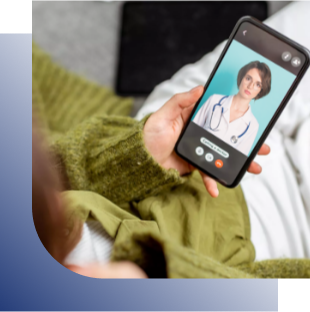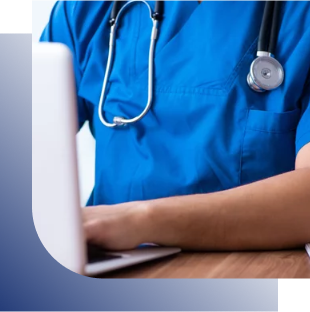Custom Features
Custom systems are built to match your unique workflows, regulatory standards, and patient demographics.

Innovation Meets Healthcare, Anytime, Anywhere
With the rapid shift in healthcare, telehealth is leading the way in
transforming how care is delivered. It allows for remote care, boosts
patient engagement, helps manage chronic conditions, and
strengthens provider collaboration.



Access to Care Anywhere:
Virtual consultations and remote monitoring provide care from any location.
Chronic Condition Management:
RPM tools track conditions like diabetes for ongoing management.
Improved Workflows:
Integrated systems streamline provider collaboration and efficiency.

Live video conferencing enables real-time patient-provider connections, which is vital during emergencies. It supports multi-participant sessions and allows specialists to collaborate on care.
By following telehealth best practices, it improves communication and treatment outcomes, while cloud-based systems ensure data security and a smooth experience.
Daily symptom surveys in telehealth provide real-time insights into patients' conditions, which improves the monitoring of mental health and comorbidities.
Clinicians can track daily health changes to ensure consistent, patient-focused care beyond virtual appointments.
Telehealth platforms send alerts and voice calls to remind patients of their medication schedules, which improves adherence and supports effective treatment.
These tools enable proactive care by helping patients and providers monitor medication use.
Telehealth software offers condition-specific education through quizzes and videos, accessible at any time, which improves health literacy and engagement. Integrating professional education equips patients with prevention strategies, better resource use, and personalized care plans.
Features like wound imaging allow patients to share recovery progress with health care specialists, enabling timely responses to complications.
Remote patient monitoring (RPM) on telehealth platforms allows real-time tracking and early detection. It reduces readmissions and hospital visits, especially benefiting rural patients.
If integrated properly, RPM improves disease management, patient satisfaction, and health outcomes. Successful RPM integration involves selecting a cloud-based platform, appropriate devices, and providing training for healthcare providers and patient education for engagement.
Telehealth enables the electronic transmission of health data to specialists, which aids comprehensive analysis, especially in rural areas. Integration with electronic medical record (EMR) systems allows seamless data exchange and improves both efficiency and care quality.
This synchronization eliminates redundant records, connects clinical and remote care, and maintains a unified, up-to-date health information repository.

Choosing between custom and off-the-shelf telehealth solutions comes down to flexibility, scalability, and integration. While ready-made platforms provide basic features, custom telehealth solutions offer wide range of advantages adapted to your specific needs
Custom Features
Custom systems are built to match your unique workflows, regulatory standards, and patient demographics.
Easy Integration
Easily connect with existing EMRs, patient portals, and healthcare systems for smoother operations.
Scalability
Custom solutions grow with your
organization, adapting as you expand services or add new specialties.
Unlike ready-made options, custom development of a telehealth platform ensures the flexibility and scalability you need for long-term success.

Patients can get care from home, which minimizes hospital visits and allows earlier intervention.
Remotely monitoring patients catches health issues early and improves chronic condition management.
Custom telehealth provides personalized care with medication reminders, educational resources, and follow-ups.

Automate tasks like scheduling, reminders, and data entry, freeing time for patient care.
Enable real-time collaboration with other providers for improved diagnosis and treatment plans.
EMR and patient portal integration offers a complete view of patient history and real-time data.

Lower costs by reducing in-person visits, infrastructure, and administrative tasks.
Offer remote consultations and RPM to attract new patient demographics.
Meet global standards like HIPAA with secure data handling and encryption.

 JavaScript
JavaScript
 Angular
Angular
 React
React
 Vue.js
Vue.js
 Kendo UI
Kendo UI
 HTML5
HTML5
 Twitter Bootstrap
Twitter Bootstrap
 PHP Laravel
PHP Laravel
 PHP Symfony
PHP Symfony
 Python
Python
 NodeJS
NodeJS
 Microsoft .Net Core
Microsoft .Net Core
 JavaScript
JavaScript
 React
React
 Microsoft SQL Server
Microsoft SQL Server
 PostgreSQL
PostgreSQL
 MongoDB
MongoDB
15 years of working on digital health products in regulated industries.
A wide variety of successful projects and industry expertise.
An innovation culture shaped by mutual trust, creativity, agility and adaptability.
We are honoured to have gained the trust of government and corporate leaders.
We seamlessly integrate to accelerate your teams, delivering world-class solutions on time and within budget.

We develop solutions that are fully secure
and compliant with the globally established healthcare standards and requirements.




We go the extra mile to communicate and understand business objectives, leading to exceptionally high project success.

All vendors claim they can do the job, so that they get it. BGO actually delivers successful projects, and NPS score is the ultimate proof of that.
We work with businesses worldwide, so get in touch!
Start your project’s success here.
We’ll be in touch within one business day.
Enhance patient engagement
Improve operational efficiency
Increase acquisition retention
Enable informed decisions
Streamline patient data
BGO is trusted by top healthcare startups, Fortune 100 companies
and governments for their
digital health solutions.
Telehealth technology uses advances in communications, computer science, and informatics to deliver remote healthcare services. This includes virtual visits, remote patient monitoring (RPM), and real-time sharing of patient data.
Telehealth and POC technologies also enhance medical care by allowing earlier detection of health issues and improving the management of chronic conditions like heart disease. They increase patient access to care, regardless of location.
RPM devices track patients' physiological data, like blood pressure, by using wearable systems and mobile phones. This information helps prevent heart failure and reduces hospital admissions.
There are NIBIB-funded researchers, developing to improve future healthcare delivery with technologies for remote care. These innovations enhance monitoring for patients with chronic conditions and allow for early intervention and improved therapy.
For example, telehealth tools can use a simple paper-based test to diagnose anemia, thus increasing the efficiency of disease management.
Telehealth, combined with POC technologies, allows healthcare professionals to monitor patients remotely and provide timely interventions.
POC technologies, including minute paper-based viral diagnostics, have become a valuable tool in diagnosing and treating conditions like anemia and cervical cancer. These innovations improve medical care by providing quick, low-cost tests and personalized treatment plans, ensuring more efficient use of healthcare resources.
Telehealth platforms synchronize with electronic medical records (EMR) to create a bidirectional workflow. This ensures that that personal health information is always up to date. This integration also enables seamless sharing of medical information, improves collaboration between healthcare providers, and enhances care for high-risk patients with chronic diseases.
Ultimately, these solutions help streamline clinical workflows, reduce redundant records, and improve overall patient care. For instance, Medicaid services can be better managed through telehealth implementation, reducing inefficiencies and costs.
NIBIB-funded scientists are developing cutting-edge telehealth technologies to improve therapy for knee osteoarthritis and heart disease. These include wearable systems, mobile health platforms, and remote patient monitoring devices that track health status in real time, which helps patients avoid hospitalization and improves therapy outcomes.
Thanks to combined advances in communications, computer science, informatics and medical technologies, telehealth has become a valuable tool for managing health status and providing patient education. This way, it empowers individuals to take charge of their care.
Back to top
Hello!
Did you know that BGO Software is one of the only companies strictly specialising in digital health IT talent and tech leadership?
Our team has over 15 years of experience helping health startups, Fortune 100 enterprises, and governments deliver leading healthcare tech solutions.
If you want to explore your options, would you like to book a free consultation call today?